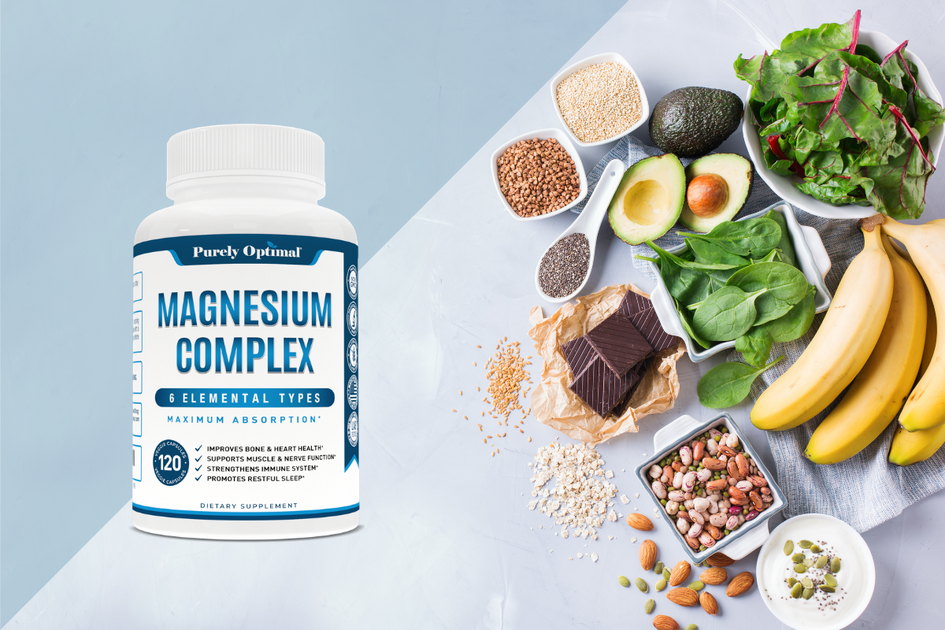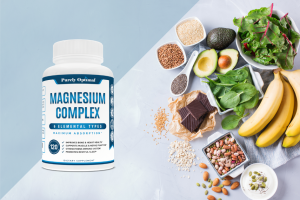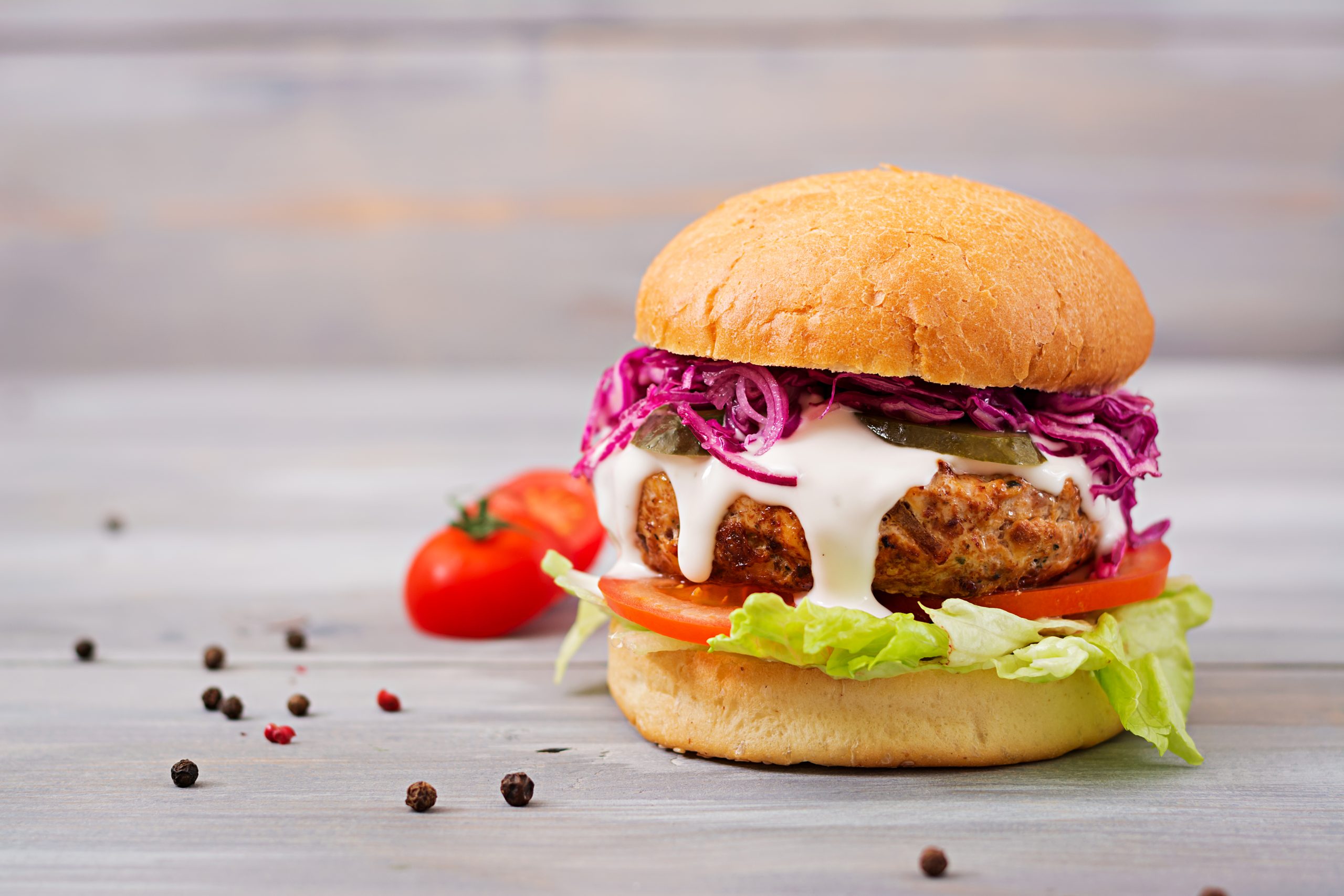Food Drink
Choosing Wisely: Magnesium Supplements vs. Dietary Sources for Optimal Health

Magnesium stands as a fundamental mineral vital for a myriad of bodily functions. Understanding the distinctions between magnesium supplements and dietary sources aids in making informed decisions for optimal health.
Introduction
Magnesium, an essential micronutrient, plays a pivotal role in various biochemical processes within the body, influencing muscle function, nerve transmission, and cardiovascular health. The article aims to elucidate the differences between magnesium supplements and dietary sources to assist individuals in choosing the most suitable option for their magnesium intake.
Understanding Magnesium
Magnesium is indispensable for enzyme activation, energy production, and regulation of calcium levels. Its role extends to nerve function, muscle contraction, and maintaining heart health, underlining its significance in overall well-being.

Image By: https://th.bing.com/
Dietary Sources of Magnesium
Natural dietary sources rich in magnesium encompass an array of foods including leafy greens (spinach, kale), nuts and seeds (almonds, pumpkin seeds), whole grains (quinoa, brown rice), and legumes (black beans, lentils). Understanding the diverse range of food options helps in creating a balanced magnesium-rich diet.
Magnesium Supplements
Magnesium supplements come in various forms such as magnesium citrate, magnesium oxide, magnesium glycinate, and more. Each type varies in bioavailability and absorption rate, impacting their efficacy and potential side effects.
Benefits and Considerations
Dietary sources of magnesium offer a plethora of nutrients alongside magnesium, contributing to overall nutrition and health. However, supplements may provide a concentrated dose of magnesium and are suitable for individuals with specific deficiencies or those requiring higher intakes.
Factors Influencing Choice
Lifestyle choices, dietary habits, stress levels, and physical activity influence the body’s magnesium requirements. Certain health conditions or medications can affect magnesium absorption, potentially indicating the need for supplements.
Addressing Deficiencies
Magnesium deficiencies can be addressed through dietary alterations, ensuring a balanced intake of magnesium-rich foods. In some cases, supplementation might be necessary to meet individual needs, particularly when dietary sources are insufficient, or absorption is impaired.

Image By: https://magsupps.co.uk
Professional Guidance and Conclusion
Seeking guidance from healthcare professionals helps in determining individual magnesium needs. Making informed choices based on personal circumstances, health conditions, and professional advice is crucial for maintaining optimal magnesium levels and overall health.
Business
Best Veggie Burger in Toronto: Taste, Texture, and Trends

Introduction
A veggie burger doesn’t have to be a boring indulgence at all. In fact, the vegetarian goodness isn’t just filled with nutrients, but you’ll also find some of the mouth-watering flavours that will leave your taste buds with an unforgettable taste.
Furthermore, you can find a veggie burger in Toronto, offered in different styles. These burgers offer varied tastes and textures, and also follow different trends that make them extraordinary.
In this article, let’s find out about these tasty, texture-rich veggie burgers that are cooked in a trendy way. Exploring this variety of burgers will ensure a satisfactory food indulgence, especially if you’re a vegetarian.
Best Veggie Burgers You Can Indulge in
Here’s a list of top vegetarian burger recipes that you can indulge in:
1. Lentil and Quinoa Patties:
Made with lentils, quinoa, bulgur, brown rice, and corn, the Lentil and Quinoa Patties offer an extraordinary vegetarian indulgence for those looking for a meat-free burger. This burger actually offers a great texture, thanks to the grainy bulgur that makes it crunchy. Plus, the corn adds to the taste, which makes it a great delicacy for any vegetarian. This burger is a great option for those following a vegetarian or a vegan diet.
2. President’s Choice Meatless Burger:
For those looking for vegetarian indulgence, the best meatless burger offered by President’s Choice is a great choice. It consists of concentrated soy protein, onion, ketchup, along with personalized milk ingredients and cellulose levels for lactose-intolerant folks.
This isn’t just a meatless burger.
In fact, if you’re following a vegetarian diet and craving something that tastes non-veg, this meatless burger can satisfy your cravings. It’s got a meat-like texture and offers a notable 29 grams of protein, making it a healthy option.
It’s even easy to cook and has a lovely layer of caramelization on the outside like a hamburger. They may be processed, but these plant-based proteins present in this burger offer a great taste. Plus, kids can also enjoy this burger due to the flavours and nutrients present in it.
3. Beyond Burger:
This is another burger that tastes just like beef or any other meat. In fact, it doesn’t include any sort of gluten and is great for a guilt-free vegetarian or vegan indulgence.
What makes the indulgence so special in this burger is the umami/meat-like smell that this burger exhibits while it’s being cooked. Ingredients include pea protein, rice protein, mung bean protein, natural flavours, and some sugar.
Another notable thing is that it consists of almost half the level of sodium as other burger recipes. Not just that, when you cook this recipe, you’ll find meat-like juices oozing out, which makes up for the meat-like texture. Hence, you can enjoy something that offers a meat-like taste and still remains thoroughly vegetarian.
4. Original Veggie Patty from Big Mountain Foods:
Another gluten-free delicacy on this list, the original veggie patty is a great option for vegetarian food lovers looking for a guiltless culinary fulfillment. Its nutty, split tea taste is something that will leave your taste buds mesmerized.
Consisting of yellow split peas, carrots, green peas, red pepper, sunflower seeds, and chia seeds, this recipe is certainly a great indulgence for those who want a great food indulgence without any meat.
5. Lentil Bean and Quinoa Burger from President’s Choice:
Looking for a vegetarian burger recipe with a dash of Italian goodness? Well, the lentil bean and quinoa burger is the right choice for you. It’s something that will remind you of the Arancini, the Italian riceballs that are rolled from leftover risotto.
What makes this burger even special is the smell of cheese emitting from it. This is the very specialty that can win over your kids, if they want something fun to eat and enjoy.
Made with brown rice, mozzarella, Parmesan, lentils, and various other ingredients, this burger contains less than half of the amount of sodium. Thus, it makes it to the list of the best veggie burgers that you can find in Toronto.
6. Deep Indian Gourmet Vegetable Masala Burger:
For those who want some authentic Indian delicacies layered in a burger, this dish is the right choice for you. Made of potatoes, carrots, green beans, bell peppers, corn, ginger, and sugar, this vegetable masala burger offers some of the finest delights for your taste buds.
7. Spicy Black Bean Burgers from Morning Star Farms:
It may sound spicy when you read the name, but the spicy black bean burger offers much more than that. Consisting of black beans, brown rice, corn, bulgur, green chilis, and dried egg, this burger dish offers a great level of nutritional goodness.
8. Sol Cuisine Extreme Griller:
Consisting of soy protein, natural flavour, caramel colour, and a blend of natural superfoods, this vegetarian burger is a great delicacy that packs its flavours pretty well.
This burger only has 6 grams of fat on offer. Furthermore, thanks to the veggie ingredients present in it, this dish is actually a healthy alternative to its meat-based counterpart, offering great indulgence.
9. Amy’s California Burger:
These burgers may not be a great choice for many, but they’re a brilliant option for those who can enjoy some gluten in their food. Easy to heat in both a pan and a toaster, this burger offers a convenient indulgence without the need of having meat.
Consisting of mushrooms, onions, bulgur, carrots, celery, and wheat gluten, this recipe is a vegetarian delight that offers an influx of flavours right delivered to your taste buds. These are some of the prominent veg burger recipes that are available in restaurants in Toronto.
Summing Up
You don’t necessarily need meat to enjoy a burger. As a matter of fact, there are many burger recipes that involve veggies only and don’t have a single layer of meat. The abovementioned recipes aren’t just about a fun indulgence, but they also come loaded with nutritional value that makes your burger feast wholesome.
Furthermore, you can even order some of these recipes or cook them at home, which makes them a convenient option for healthy and fun eating that doesn’t compromise on flavours.
Food Drink
6 Holiday Catering Menu Ideas Everyone Will Love This Season

Introduction
Holiday gatherings are built around food. That’s just how it goes. Whether it’s a big family dinner or an office party, the right menu brings people together faster than any decoration or playlist ever could. But if you’ve ever been in charge of planning, you know how stressful picking the dishes can be. That’s where a solid holiday catering menu saves your sanity.
The trick is finding a balance between traditional comfort food and fresh, seasonal flavors. You want dishes that feel special but still familiar. Here are six menu ideas that make any holiday event feel like something worth celebrating.
6 Holiday Catering Menu Ideas Everyone Will Love This Season
1. Traditional Comfort Classics
Some foods never lose their magic. A juicy roasted turkey, honey-glazed ham, creamy mashed potatoes, and warm dinner rolls—these dishes are the backbone of most holiday meals for a reason. They’re cozy, satisfying, and instantly put everyone at ease.
If you’re hosting a larger crowd, a buffet setup works best. People can grab what they love, skip what they don’t, and go back for seconds without a fuss.
It’s also smart to include a vegetarian main dish. Something like butternut squash risotto or a rich vegetable lasagna keeps everyone happy and avoids those awkward “what can I eat?” moments.
2. Modern Holiday Favorites
If you want to mix things up, go for a lighter, more modern menu. Think citrus-glazed salmon, roasted Brussels sprouts with balsamic drizzle, or wild rice with cranberries and pecans. These kinds of dishes still feel festive but add a fresh twist to the usual lineup.
Don’t underestimate presentation. A sprinkle of herbs or a bright garnish can turn a simple meal into something people remember. The holidays are busy enough; your food doesn’t have to be complicated to feel special.
3. Global Holiday Flavors
Holiday food doesn’t have to stick to the same few recipes every year. A global-inspired menu brings a new kind of excitement to the table. A Mediterranean spread with roasted lamb, hummus, and tabbouleh feels vibrant and colorful.
Or go in a completely different direction with Asian-inspired dishes like teriyaki chicken, fried rice, and vegetable spring rolls. For a warm, lively vibe, try a Mexican-style menu with tamales, fajitas, and churros.
A mix of flavors from around the world keeps guests talking and gives your event something different from the typical turkey-and-gravy dinner.
4. Elegant Small Bites and Appetizers
Not every event needs a sit-down meal. For cocktail hours or office mixers, small bites are the way to go. Mini crab cakes, skewered shrimp, stuffed mushrooms, or bite-size charcuterie cups make it easy for guests to snack and mingle at the same time.
When you mix savory and sweet options, you get the perfect balance. Pair prosciutto-wrapped melon with chocolate-dipped strawberries, and suddenly your spread feels both polished and fun.
Finger food catering also takes a lot of pressure off timing. You can serve in rounds, refill as needed, and keep the vibe casual and relaxed.
5. Sweet Finishes That Steal the Show
Desserts always end up being the crowd favorite. Whether it’s pumpkin cheesecake, pecan pie bars, or mini chocolate mousse cups, everyone wants a bite of something sweet before they leave.
You can make dessert interactive, too. A build-your-own cookie or hot chocolate station adds a playful touch and keeps the energy light. It’s simple to set up, and people love customizing their treats.
If you’re working with a local catering team, many now offer dessert packages that perfectly match your main menu. It’s one less thing to worry about, and it ties the whole meal together.
6. Breakfast or Brunch Holiday Catering
Morning celebrations deserve great food too. Brunch catering is perfect for office gatherings or family mornings where you want something easy and cheerful.
Put together a spread with scrambled eggs, crispy bacon, breakfast potatoes, and mini pancakes or waffles. Add yogurt parfaits with granola and fruit for a lighter touch, and don’t forget the coffee. Always the coffee.
Brunch feels casual and fun, and it’s usually simpler to plan than a full dinner. Plus, who doesn’t love an excuse for mimosas before noon?
How to Pick the Right Menu
Before locking in your catering order, think about your group. A formal dinner with assigned seating calls for plated service. A casual family event? Go buffet-style and keep it easy.
Check on dietary restrictions early so your caterer can plan accordingly. The last thing you want is someone skipping half the meal because nothing fits their diet.
And book early. The holidays are busy for catering companies, and the best ones fill up fast.
Wrapping It Up
A great holiday menu sets the tone for your entire event. Whether you’re keeping things classic or going bold with international dishes, good food makes people feel connected.
If you’re in Houston, you’ll find plenty of catering teams that know how to handle the busy holiday season. They take care of setup, service, and cleanup, so you can actually enjoy your own party.
The best events aren’t about perfection. They’re about people sitting around a table, eating good food, and sharing a little bit of joy before the year ends.
Food Drink
Celebrate the Season with the Best Christmas Cakes in Toronto

Introduction
The holiday season is all about joy, togetherness, and of course — delicious treats. At Irresistible Cakes (iCakes), our Christmas cakes Toronto are baked to capture the true magic of the season. From rich chocolate layers to beautifully decorated fruit cakes, every bite is a reason to celebrate.
Whether you’re hosting a family dinner or gifting a sweet surprise, iCakes offers the perfect blend of taste, creativity, and festivity for this special time of year.
The Magic of a Perfect Christmas Cake
Nothing defines the holidays like a beautifully designed Christmas cake. At iCakes, we take pride in crafting the most delightful Christmas cakes Toronto that combine seasonal flavours, elegant designs, and a sprinkle of holiday cheer.
Our expert bakers use the finest ingredients premium cocoa, dried fruits, nuts, and butter to deliver a cake that’s moist, rich, and bursting with flavour. Each creation is decorated with festive colors, snowflakes, and handcrafted toppers to make your celebrations unforgettable.
Add a Twist with Chocolate Christmas Cake
If you’re a chocolate lover, our chocolate Christmas cake will be the highlight of your holiday table. Perfectly balanced between sweetness and richness, this cake brings comfort in every slice.
Ideal for family gatherings, office parties, or cozy nights by the fire, it’s a decadent treat everyone will remember. Choose from classic buttercream finishes, ganache drips, or festive fondant art to personalize your dessert for the season.
For Traditionalists: Classic Christmas Fruit Cake
There’s something timeless about a traditional fruit cake during the holidays. Our christmas fruit cake for sale features a medley of dried fruits soaked in rich flavors, baked slowly to perfection.
At iCakes, we’ve modernized the traditional recipe with a soft texture and a perfectly balanced sweetness. Whether served plain or glazed, it’s a heartwarming dessert that symbolizes celebration, family, and love.
Order Custom Cakes for Every Celebration
The joy of the holidays doesn’t stop at Christmas. Whether it’s a birthday, a wedding, or a corporate gathering, our custom cakes Toronto are designed to match every theme and taste.
From elegant tiered cakes to fun character-inspired designs, iCakes turns your vision into reality. With our skilled decorators and endless customization options, every cake we bake becomes a one-of-a-kind masterpiece made just for you.
Sweet Treats for Every Occasion
Beyond festive desserts, we’re known for creating cakes that suit every milestone. Our anniversary cake design Toronto range, for instance, offers luxurious designs with intricate detailing, perfect for celebrating love and commitment.
If you’re celebrating with your colleagues, our corporate cakes Toronto add a professional yet delicious touch to office gatherings. And for birthdays, our kids birthday cake Toronto options are full of color, creativity, and joy because every little moment deserves to be celebrated sweetly.
Why Choose iCakes for Your Holiday Celebration?
When it comes to Christmas cakes Toronto, iCakes stands out for its quality, creativity, and customer-first approach. Here’s why our cakes make every occasion special:
- Artisan Craftsmanship: Each cake is handmade by skilled bakers with a passion for perfection.
- Premium Ingredients: We use only the freshest and finest ingredients for a premium taste.
- Endless Customization: Choose from a variety of flavors, fillings, and festive designs.
- Convenient Ordering: Enjoy smooth online cake delivery Toronto across the GTA.
- Guaranteed Freshness: Every cake is baked to order and delivered with care, ensuring freshness in every slice.
Celebrate with iCakes: The Heart of Every Holiday Table
This Christmas, make your celebrations sweeter, brighter, and more memorable with iCakes. Whether you’re craving a special Christmas cake, a rich chocolate indulgence, or a fruity festive delight, we have something for everyone.
Order early and let our team craft a cake that truly reflects your holiday spirit. With the finest cake delivery in Canada Toronto, your festive centerpiece is just a click away.
Final Slice
This festive season, let iCakes add sweetness and style to your celebrations. Our handcrafted Christmas cakes Toronto are baked with passion, designed with care, and delivered with love. Whether it’s for family, friends, or colleagues, our cakes bring everyone together around the table of joy.
So go ahead spread the cheer, share the sweetness, and make this Christmas truly irresistible.
FAQs
Q1. What types of Christmas cakes do you offer?
We offer a variety including chocolate Christmas cake, special Christmas cake, and traditional christmas fruit cake for sale, each customizable to your liking.
Q2. Can I get my Christmas cake delivered on a specific date?
Yes! With our online cake delivery Toronto, you can schedule your cake delivery to arrive fresh on your chosen date.
Q3. Do you offer corporate Christmas cakes for offices?
Absolutely. Our corporate cakes Toronto are ideal for office events, client gifting, and festive team parties.
Q4. Can I customize the design of my Christmas cake?
Of course! iCakes specializes in custom cakes Toronto, ensuring every detail — from design to flavor — is made to your taste.
Also, read more interesting blogs here
-
Business2 years ago
Cybersecurity Consulting Company SequelNet Provides Critical IT Support Services to Medical Billing Firm, Medical Optimum
-
Business2 years ago
Team Communication Software Transforms Operations at Finance Innovate
-
Business2 years ago
Project Management Tool Transforms Long Island Business
-
Business2 years ago
How Alleviate Poverty Utilized IPPBX’s All-in-One Solution to Transform Lives in New York City
-
health2 years ago
Breast Cancer: The Imperative Role of Mammograms in Screening and Early Detection
-
Sports2 years ago
Unstoppable Collaboration: D.C.’s Citi Open and Silicon Valley Classic Unite to Propel Women’s Tennis to New Heights
-
Art /Entertainment3 years ago
Embracing Renewal: Sizdabedar Celebrations Unite Iranians in New York’s Eisenhower Park
-
Finance3 years ago
The Benefits of Starting a Side Hustle for Financial Freedom






























